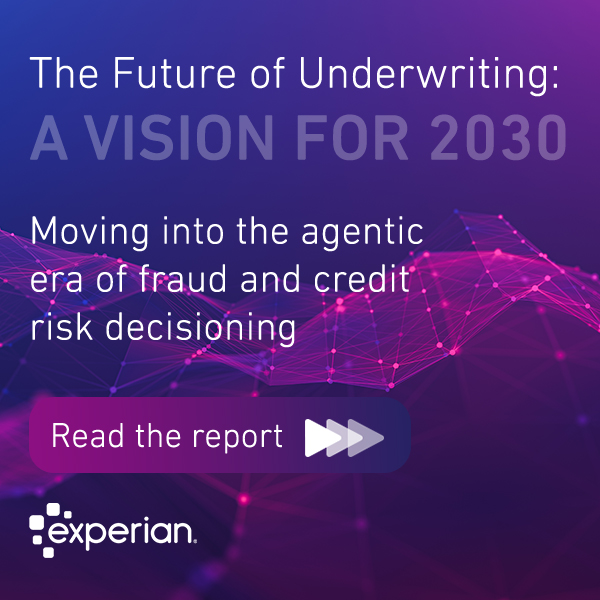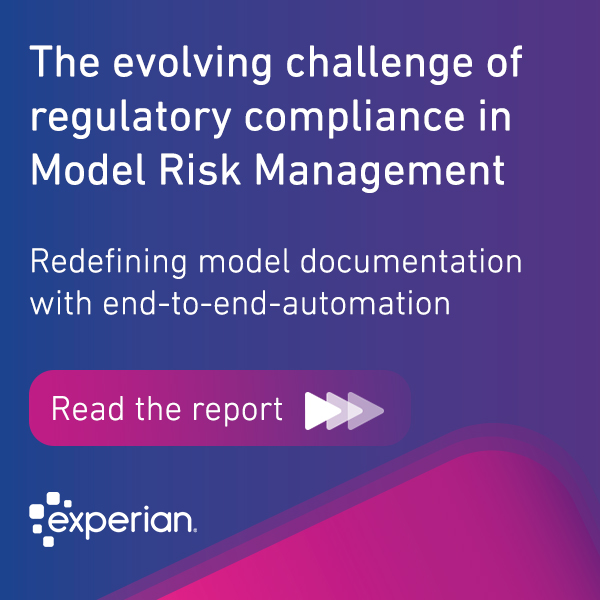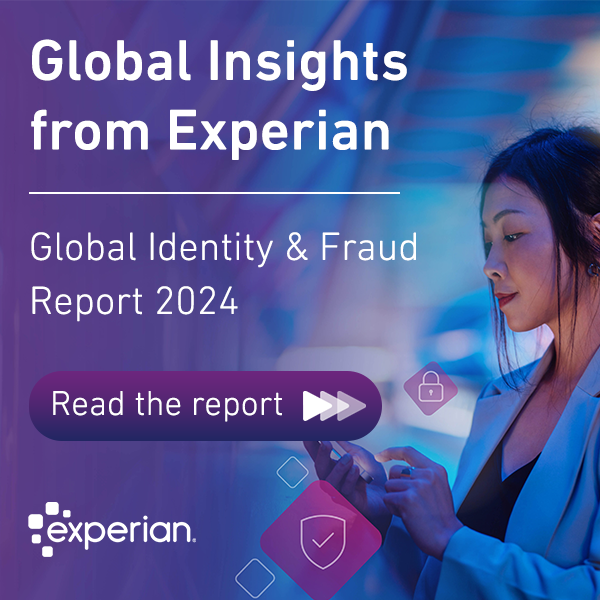Tech Today
We explore what businesses are doing today in the application of available data, advanced analytics and innovative technologies.

Did you miss these August business headlines? We’ve compiled the top global news stories that you need to stay in-the-know on the latest hot topics and insights from our experts. Categorizing Fraud Types is the Key to Addressing Risk Security Magazine's Chris Ryan uses Experian research to break down why businesses need to first identify and understand the individual types of fraud before being in the position to address risk, especially when operating in an increasingly digital age. How To Protect Yourself Against Scammers and Deepfakes In this video, Philip Michael of Bold TV talks to David Britton, VP of Industry Solutions, about what fraud looks like in an AI-driven world, what exactly Deepfakes are, how they can be used in financial scams, and how Experian is using tools like AI and ML to fight back. Today’s Credit Decisioning: Navigating the Current Complexities The science of consumer credit decisioning is complex, writes Harry Singh, SVP of Global Decisioning, for Credit Union Times, but what has the pandemic done to further these complexities? This piece explains why lenders need to rethink existing models and processes to succeed in changing times. Experian Named Top Fraud Prevention Leader in International Analyst Report Research from KuppingerCole lists Experian as an overall leader in fraud reduction intelligence platforms. The research also recognized leadership in product, market and innovation, and across all other categories. Read about why this is important as fraud risks rise. How To Combat Fraudsters As The Digital World Grows In this piece for CEO World, David Britton, VP of Industry Solutions, writes about the relentless nature of fraud and why the goal of fraudsters never changes, and what businesses and individuals must to in the face of an ever-evolving fraud landscape in an increasingly digital world. Stay in the know with our latest research and insights:

Fraud has been exacerbated by the Covid pandemic, and with total cybercrime costs set to reach $10.5 trillion by 2025 according to Cybersecurity Ventures*, many businesses are looking to protect themselves and their customers from fraudsters. As the world moves further towards digital interactions across services and eCommerce, new fraud targets are emerging, and although financial services are more accustomed to these attacks compared with new targets, they are still favorites among the criminals. KuppingerCole's Leadership Compass report on fraud reduction intelligence platforms, highlights Experian as a leader across product, innovation and market. *Cybersercurity Ventures

Did you miss these July business headlines? We’ve compiled the top global news stories that you need to stay in-the-know on the latest hot topics and insights from our experts. Anthony Bourdain Deepfake Controversy Points to Pitfalls of AI-Generated Content As synthetic media grows more popular as a creative tool, creators must navigate new ethical ground, reports Adweek's Patrick Kulp. David Britton, VP of Industry Solutions explains why we will see more deepfakes as the technology embeds, and how the ID & Fraud prevention and detection industry is responding. Tech-driven credit management solutions are key for businesses in post-Covid world, says new report The Business Times takes a look at how, according to Experian's latest Global Decisioning report, businesses need to respond and adapt to consumers' growing digital needs after an acceleration in digital interactions during the pandemic. Selfie biometrics for online pet sales and financial services among latest remote onboarding launches Biometric Update uncovers the latest in remote onboarding implementations, reporting on its promising steady pace and highlighting Juniper Research's recognition of Experian's industry-leading ID & Fraud solutions in this field among its peers. Validating Identities In A Digital World Bloomberg's Paul Sweeney and Matt Miller talk to David Britton, VP of Industry Solutions, in this radio piece about the importance of validating identities in a growing digital world, and what we might need to see from ID & Fraud solutions in the future to ensure that individuals are secure online. How Businesses Can Adapt to Rising Customer Expectations Donna DePasquale, EVP of Global Decisioning Software writes in CXO Today about the importance of customer journey in credit risk decision-making, taking businesses through the customer lifecycle to show how to avoid disruption during each digital interaction and touchpoint, while implementing the best decision analytics. Stay in the know with our latest insights:

Did you miss these June business headlines? We’ve compiled the top global news stories that you need to stay in-the-know on the latest hot topics and insights from our experts. Fintech Interview with Executive Vice President, Experian – Eric Haller FinTech Buzz talks to Eric Haller, VP & General Manager, Identity, Fraud & DataLabs, about various key trends and challenges in the Digital Identification domain and how fintech prevents fraud in the financial market. Experian on Fraud: 2020 Was a Big Year for Nefarious Actors and Illicit Activity in Financial Services David Britton, VP, Industry Solutions, Global ID and Fraud at Experian, recently shared with Crowdfund Insider Experian’s insight into fraud and what the business is doing to combat nefarious activity in financial services. Evolution of digital identity Professional Security Magazine Online talks to David Britton, VP of Industry Solutions, about how the preference for digital-first was sparked and then accelerated through the Covid-19 pandemic, but the concept of digital identity and the need for its evolution will remain prevalent for both consumers and businesses way beyond that. Preventing fraud without compromising the customer experience Finextra looks at Experian's Global Identity and Fraud Report 2021 to uncover why customer experience is central to the approach for businesses when balancing fraud prevention and revenue. Three things lenders need to do to navigate today’s complex lending and credit landscape Business Information Industry Association covers Experian's Global Decisioning Report 2021 highlighting the dual-lane economy and what lenders can do to succeed in this complex and changing landscape. Stay in the know with our latest insights:

Digital payments have grown rapidly over the last year. Even before the pandemic, people were adopting digital payments. Now, after efforts from governments around the world to enforce social distancing, we've seen huge growth in this type of payment as consumers move away from in-person and contact payments. Juniper Research has released its Online Payment Fraud Report 2021 exploring why the increase in digital payments has created expansive opportunity for new methods of fraud.

Donna DePasquale, EVP, Global Decisioning Software, talks to Bloomberg Quicktakes about the key findings of the latest Global Decisioning Report. Some key takeaways from the interview: Covid-19 has created an even wider two-lane economy 1 in 3 consumers remain concerned about their finances Lenders need to prepare for a wave of potential delinquencies Around 50% of lenders are investing in model recalibration to deal with the changes caused by the pandemic One third of lenders are creating new credit models We surveyed 9,000 consumers and 2,700 businesses across ten countries worldwide. Download the Global Decisioning Report 2021:

As we enter the beginning of the end of this global crisis, the role of data, analytics, and credit risk decisioning takes on even greater significance than before. Consumers face uneven roads to recovery, with some ready to spend again and others still mired in pandemic-related financial stress. And businesses of all sizes report their operations are recovering but there’s still a way to go. A key difference we saw is that companies that adapted to serve customer needs digitally are faring much better. Our 2021 Global Decisioning eBook, Navigating a new era of credit risk decisioning, looks at how consumers are stabilizing their finances and how businesses are returning to growth. A recent survey among 9,000 consumers and 2,700 businesses across ten countries worldwide reveals the importance of lenders prioritizing digital transformation, and the role of advanced data and analytics in enhancing the customer experience. The pandemic fall-out is impacting everyone differently: 1 in 3 consumers remains concerned about their finances – paying bills and managing credit Whereas high-income households are no longer reducing their discretionary spending Navigating this varied credit landscape requires a deep understanding of customer needs on both ends of the spectrum. However, business confidence in the consumer credit risk management analytics models dropped over the past year from 71 percent to 61 percent. Smaller lenders with revenues ranging from $10M to $49M have seen the sharpest decline from 72 percent to 57 percent in the past six months. Adapting data and analytics to a rapidly changing customer base: Almost 50% of businesses surveyed said their dedicate more resources to enhance analytics One-third of businesses are planning to re-build their models from scratch Recalibrating credit models is one thing, but lenders also need to rethink their data sources to better understand current customer profiles. The data inputs generated by the pandemic have impacted credit risk models and machine learning applications in unexpected ways. For example, widespread payment holidays and government stimulus programs may be masking customers’ true financial circumstances. According to Recovery Insights, a separate study published by Experian North America: Delinquency prior to the pandemic is a strong indicator of future risk. Accounts exiting an accommodation period are 2x more likely to become delinquent than are accounts that never received an accommodation. Payment on debt during accommodation indicated a reduced risk for subsequent delinquency. Amidst the pandemic lockdown, consumers turned online to manage finances and connect with lenders – including older consumers. And while the pandemic pushed consumers online out of necessity, now that they’re there – it’s become a preference – as overall digital gains are holding above pre-pandemic levels. Lenders have a new digital imperative to meet consumers’ evolving needs for continued digital engagement. Consumer expectations of digital experiences 55% of consumers have higher expectations of their digital experience since Covid-19 began 43% of consumers surveyed age 70+ reported digital banking throughout the pandemic 14% of consumers surveyed age 60-69 applied for a new loan or card online The importance of a digital-first approach has revealed itself and many companies have put a digital customer journey in place since Covid-19 began. The future, however, is more than providing online services. It’s about knowing your customers well enough to anticipate their credit needs and using tools to automate the process and reduce risk. Adapt or lose customers 9 in 10 businesses have a digital customer journey in place 1 in 4 consumers have taken their business elsewhere because a company didn’t adapt to their digital needs Online customer experience and credit risk management are more connected than ever before. And, businesses need technology that supports the entire customer journey, from onboarding to customer management to collections. Five digital investments businesses are prioritizing the new era of credit risk management: Implement new machine learning models for customer decisions Increase digital acquisitions and engagement Understand their customer base (affordability, value, behavior) Automate customer decisions Increase value of existing customers Access the report here to get more consumer trends and find out what the future of decisioning means for businesses looking to return to growth. Stay in the know with our latest insights:

Did you miss these May business headlines? We’ve compiled the top global news stories that you need to stay in-the-know on the latest hot topics and insights from our experts. APAC businesses focus more on revenue generation than fraud prevention Disruptive Asia looks at the latest Experian research uncovering how businesses across the Asia Pacific (APAC) region are deprioritizing security and fraud prevention. The survey found that nearly one-third favor an emphasis on revenue generation, an approach that could increase the risk of an already vulnerable digital ecosystem for consumers across the region. How sophisticated security methods can help in the battle against online fraud The National Cyber Security Centre (NCSC) has removed more scams in the last 12-months than in the previous three years combined. Finextra looks at how consumer insights from Experian's latest research uncover priorities around online security. Experian, Temenos Offer Instant Prescreen, Credit Solutions Pymnts.com reports that Experian and major banking software player Temenos have integrated their offerings to create a seamless way for lenders to extend credit. The arrangement relies on what Experian calls a “prequalification” process. eSPEAKS with Chris Preimesberger and David Britton eWeeks, Chris Preimesberger interviews David Britton, the VP of Industry Solutions at Experian. They discuss the new Experian report and study, the future of biometrics, and security trends. Experian Showcases Innovation Using Artificial Intelligence AIthority covers Experian’s best-in-class digital credit risk decisioning solutions have garnered industry-wide recognition, winning two recent awards focused on application excellence in artificial intelligence. Stay in the know with our latest insights:

In a recent DataTalk interview, I had the chance to reflect on and discuss how we define digital identity these days. The big digital shift we have been immersed in since the coronavirus pandemic started has certainly changed the way we create, relate to, and protect our identities online. One of the most interesting aspects of this change is that the majority of people don't think about how they're being represented online; there's a lot of information that represents us that we don't typically take ownership over. We don't tend to think about that, but it's absolutely vital to the whole process. In this regard, this year’s Global Identity & Fraud Report shows that 8 in 10 businesses now have a customer recognition strategy in place, up 26% since the start of the pandemic. Many companies also developed digital strategies as they strove to improve their online experience and provide security and fraud prevention measures when customers needed it most. That certainly marks an inflection point, as for 55% of consumers globally, security is the most important element of their online experiences. Covid-19 has changed the definition of digital identity The covid-19 pandemic has impacted the way people rely on technology for their day-to-day interactions, from shopping to banking to digital identification. It’s particularly interesting seeing how for people that weren't really engaged online before, that weren't big believers in the whole idea of buying goods and services online, the risk of walking into a store during the pandemic outweighed their fears of shopping online. That translated into about 20% of the population moving their shopping online in the last twelve months, per Experian’s 2021 Global Identity & Fraud Report. Looking ahead, the expectation is that 46% of consumers worldwide purchase and do more things online, even when physical stores and venues are safe to go back in again, meaning that people’s digital footprint is growing faster than ever. In this context, we could define digital identity as how we represent ourselves in a digital environment and how do people recognize us. For example, in the same way that years ago a good way to identify someone was looking up that person’s address and phone number, as landlines become a thing of the past, it’s possible to validate someone’s identity online using data gathered from mobile phones. The majority of people wouldn’t share those with anyone else, so their mobile phone becomes a really strong representation of their identity in the digital world. Today, opening our mobile phones with our thumbprint or via facial recognition feels very normal (that’s already part of our digital identity). Something similar happens with voice biometrics, IP addresses and device information, sources for identity data that are gaining prevalence in the digital-first world. All this identity data that is generated in the background starts to add up and creates uniqueness, helping people get recognized digitally. Related Content The race to Digital Identification, a DataTalk with Eric Haller What is digital identity and why should we care What are consumers the most concerned about when it comes to digital iterations

Digital interactions have been the norm for some time, and have recently accelerated due to the pandemic, surfacing digital identity as a fundamental focal point for businesses. A shift from analog identity to digital is happening organically due to digital demand, but the necessity of safeguards from businesses and policymakers, and an understanding of what it means to have a digital identity from consumers, make this a complex and increasingly important topic. "Sometimes it's easier to think about analog and how that might relate to digital. Our analog life, our identity, is pretty straightforward. We're all used to showing a driver's license, an identity card, or a passport. It's been authenticated by somebody that we trust like the government. It's something that we use as an entry point to open up our first checking account at the bank or when we go to the doctor's office and we provide insurance and our identity. In the digital world, it's very similar. If you think about that provenance or that trusted source of identity, it often starts with some things that we don't even see. That digital footprint is growing and expanding into a lot of pieces of information that most of us aren't familiar with or think about. That data becomes the gateway to how we access goods and services in a digital environment." Eric Haller In this CXO Talk, Michael Krigsman asks Eric Haller, Executive Vice President and Group Head of Experian DataLabs, what it means to have a digital identity and why it's important. They take a look at the following topics: What is digital identity? How do you establish digital identity? How to improve digital identity? How can we protect against AI-generated deep fakes? What is the intersection of digital identity and GPT-3? Blockchain and digital identity Societal implications of digital identity Advice to businesses and policymakers on digital identity

There's been lots of discussion about what a return to normal will look like as we transition out of the global pandemic—and much remains up the air. However, our recent consumer and business surveys paint a picture that merits the attention of financial service and credit companies. The big takeaway: The Covid-19 crisis has bifurcated consumers, created extremes on both sides. On the one hand, many individuals coming out of the pandemic have more cash than they had going in. The crisis didn't impact their income, and instead, they've spent the year spending less than they usually would due to work-from-home mandates and local lock-downs. Our consumer survey from January 2021 shows that financial challenges have eased for younger consumers and higher-income households. Yet, at the same time, there's also a contingent of consumers who continue to struggle. One in three of our survey respondents reported that they still have financial concerns and a similar percentage are worried about their employment. We anticipate that the demand for support, service, and credit will be high from each side. So how can companies respond to the heightened need for credit products while continuing to service consumers who may need support? This is where digital solutions make all the difference. By employing digital onboarding and decision automation tools, you can rapidly increase your capabilities while also improving the online customer experience for all. A return to spending The U.K. provides a glimpse of what a staggered return to normalcy may look like. When shops and restaurants re-opened for business in mid-April, lines of people streamed out the doors and flooded the streets. With the country's re-opening culminating in June, many consumers will be looking to resume spending on items and projects that they've neglected since the pandemic's start. For example, our survey data reveals that consumers are becoming less cautious with their finances in general. Fewer people report that they're cutting back on discretionary spending and there's a decline in consumers putting money toward emergency funds and drawing funds from savings accounts. These consumers may be gearing up to spend more. And companies that can anticipate their needs and meet them proactively will be positioned to win and keep their business. Solutions for pent-up demand Many businesses are already preparing for this new wave of demand. Consider that eight out of 10 businesses report that they're turning to cloud-based decisioning applications to improve the customer journey. In doing so, companies are giving themselves much-needed flexibility right when it's needed most. They can dial up their online capabilities based on demand and then dial down if it drops. At the same time, these automated solutions enable companies to deploy their staff to customers who do require personal attention. It's a divide-and-conquer model that keeps the customer at the center. In addition to utilizing the cloud, more than 40% of companies say they leverage AI to improve the customer experience. The AI component enables companies to provide personalized options for consumers and create customer journeys that are far more relevant. The timing for such personalization couldn't be better. In our research, a growing percentage of consumers indicate they're willing to share more personal data about themselves in exchange for improved experiences and added value. Building solutions that work—for everyone The pending volume creates a significant growth opportunity and highlights why digital solutions are a must. Companies that provide the best digital service to customers will garner their trust, loyalty, and even referrals. This yields more demand, increasing the need for scalable, cloud-based onboarding and decisioning even more. Amid this activity, you'll want to focus on getting the most from your digital tools. To do so, consider: Leveraging data for improved credit outcomes Evaluate your end-to-end customer journey, looking for ways to utilize data and increase personalization at every juncture. You'll improve the customer experience and provide more relevant offers. The right data also provides a holistic picture of customer credit risk and ensures you're not creating problems for the future. Utilizing low-code solutions so employees can dive in Digital onboarding and decision automation can be game-changing for the customer experience. But if it's hard for employees to use, then that effectiveness takes a hit. Look for solutions that your employees can use off the shelf. The ability to generate customizable reports and execute on ideas and strategies without involving IT at every turn is essential. Recognizing limitations and potential bias Evaluate your analytics models and look for areas of limitation or potential bias. You want to ensure that you're providing access to credit to all eligible customers and not inadvertently excluding specific demographics. Building capabilities that put you ahead of the market The pandemic provided many lessons—and the value of anticipating demand or potential problems was one of the most important. The crisis is waning, but the financial consequences will continue to reverberate, especially as various government aid programs come to an end. Focus on improving your analytics so that they can better describe what's happening now and predict pending changes in demand and shifts in your portfolio. By and large, consumers are moving forward after a challenging year. Prioritize your digital solutions to make sure you can meet their needs regardless of what the future holds. Stay in the know with our latest insights:

Did you miss these April business headlines? We’ve compiled the top global news stories that you need to stay in-the-know on the latest hot topics and insights from our experts. Consumers prefer 'invisible security' to passwords Using Experian's latest research, Venture Beat looks at the top three physical and behavioral 'invisible security' methods and why consumers no longer prefer visible online security such as passwords. Experian’s identity GM addresses industry’s post-Covid challenges How are CIOs and IT leaders dealing with new challenges created by the move of so much commerce from in-person to online? Information Week explores why security and identity verification are key priorities right now. Will passwords finally be a thing of the past? Consumers are more concerned about online privacy and identity theft than they were before the pandemic. CNP covers why warnings from data and fraud experts about the security of passwords have finally caught the attention of consumers. The future of secure data Eric Haller, Vice President & General Manager of Identity, Fraud & DataLabs, joins Bloomberg's Scarlet Fu to discuss the waning age of password protection and what the future of account security will look like. Consumers recognize biometrics security tops passwords, Experian says Biometric Update explores why physical biometrics like facial recognition and fingerprints are the preferred method of authentication when it comes to consumers according to Experian's latest research. Stay in the know with our latest insights:




